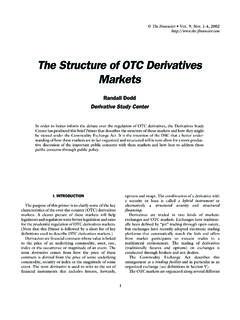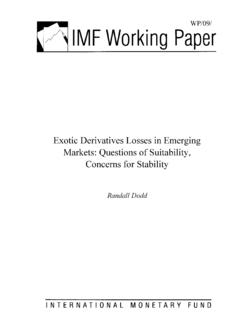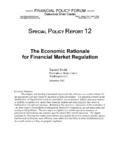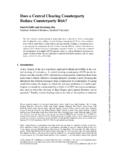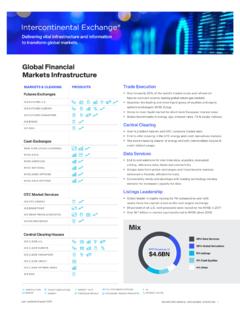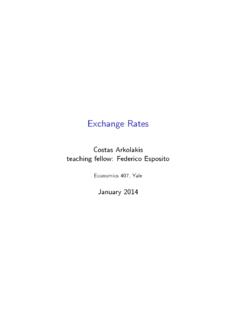Transcription of Derivatives Markets - FINANCIAL POLICY
1 FINANCIAL POLICY FORUM Derivatives STUDY CENTER 1660 L Street, NW, Suite 1200 Washington, 20036 Derivatives Markets : Sources of Vulnerability in FINANCIAL Markets Randall Dodd Director, Derivatives Study Center November 15, 2001 Updated May 10, 2004 Abstract: This paper studies the ways in which Derivatives Markets pose several types of public interest concerns to the US economy by creating new and greater sources of vulnerability.
2 The first and most obvious concern is the way in which Derivatives Markets expand risk-taking activity relative to capital. By enhancing the efficiency of transactions and the leveraging of capital, Derivatives can increase speculation just as well as they lower the cost of hedging. Secondly, Derivatives Markets can provide new opportunities for destructive activities such as fraud and manipulation; and they can facilitate unproductive activities such as outflanking prudential FINANCIAL market regulations, manipulating accounting rules and evading or avoiding taxation. The third concern involves the creation of new types and levels of credit risk as OTC Derivatives contracts are traded in order to shift various types of market risk.
3 The new credit risk is not subject to collateral ( margin) requirements, and is not handled in the most economically efficient manner. The fourth concern is the liquidity risk, especially in the interest rate swaps market , which is susceptible to creditworthiness problems at one or more of the major market participants. The last concern is systemic risk, arising especially from the OTC derivative Markets , and the strong linkages between Derivatives and underlying asset and commodity Markets . The paper will conclude with a proposal for prudential regulatory measures that will address these public interest concerns. I. INTRODUCTION Derivatives are FINANCIAL contracts that are designed to create market price exposure to changes in an underlying commodity, asset or event.
4 In general they do not involve the exchange or transfer of principal or Rather their purpose is to capture, in the form of price changes, some underlying price change or event. The term derivative refers to how the price of these contracts are derived from the price of some underlying security or commodity or from some index, interest rate, exchange rate or event. Examples of Derivatives include futures, forwards, options and swaps, and these can be combined with each other or traditional securities and loans in order to create hybrid instruments or structured securities (see Appendix I below for a primer on derivative instruments).
5 Derivatives are traded on Derivatives exchanges, such as the Chicago Mercantile exchange which employs both open outcry in "pits" and electronic order matching systems, and in over-the-counter Markets where trading is usually centered around a few dealers and conducted over the phone or electronic Derivatives play a useful and important role in hedging and risk management, but they also pose several dangers to the stability of FINANCIAL Markets and thereby the overall economy. As a testament to their usefulness, Derivatives have played a role in commerce and finance for thousands of years. The first known instance of Derivatives trading dates to 2000 when merchants, in what is now called Bahrain Island in the Arab Gulf, made consignment transactions for goods to be sold in Derivatives trading, dating back to the same era, also occurred in Mesopotamia (Swan, 1993).
6 The trading in Mesopotamia is evidenced by many clay tablets in the cuneiform writing, and these are available at the British Museum, the Louvre and were some of the many items stolen from museums in Baghdad during the invasion in 2003. A more literary reference comes some 2,350 years ago from Aristotle who discussed a case of market manipulation through the use of Derivatives on olive oil press capacity in Chapter 9 of his Derivatives trading in an exchange environment and with trading rules can be traced back to Venice in the 12th Forward and options contracts were traded on commodities, shipments and securities in Amsterdam after The Japanese traded futures-like contracts on warehouse receipts or rice in the 1700s.
7 In the US, forward and futures contracts have been formally traded on the Chicago Board of Trade since 1849. As of 2003, the world's largest derivative exchange is the Eurex which is an entirely electronic trading " exchange " that is based in Frankfurt, Germany. 1 ) The most common exception to this general rule is foreign exchange swaps in which that actual currency is exchanged, and to a lesser extent when futures or options are held to maturity so as to require delivery of the underlying item. 2 ) For a description of the OTC market see Dodd (2002). 3 ) This is the claim made by the Futures Industry Association in their 1984 publication An Introduction to the Futures Markets , and it is cited in Markham (1994) and Markham (1987).
8 4 ) It is not entirely clear from the available translation whether these Derivatives were options or forward contracts. See Appendix II for the relevant section of the text. 5 ) See Swan (1993). 16 ) See Edward Chancellor (1999) for an excellent analysis of the meaning of the 1595 laws. Today the size of Derivatives Markets is enormous, and by some measures it exceeds that for bank lending, securities and insurance. Data collected by the Bank of International Settlements (BIS) show that the amounts outstanding in the over-the-counter (OTC) market exceed $ trillion and those at Derivatives exchanges exceed $ trillion for a total of $236 trillion by the end of 2003.
9 Trading volume on Derivatives exchanges through the end of 2003 exceeded $ trillion (see Tables 1 and 2 from BIS data). According to these measurements, the size of the Derivatives market is huge. So big that it challenges descriptions akin to description of the size of space. Douglas Adams, author or The Hitchhiker's Guide to the Galaxy, tried to say it like this, "Space is big. Really big. You just won't believe how vastly hugely mind- bogglingly big it is. I mean, you may think it's a long way down the road to the chemist, but that's just peanuts to space." Thus one benchmark is to compare the market to the $11 trillion size of the US gross domestic product.
10 Thus outstanding amounts are 19 times the size of the US economy, while trading volume on exchanges is over 79 times the US GDP. Today, Derivatives are used to hedge the risks normally associated with commerce and finance. Farmers can use Derivatives the hedge the risk that the price of their crops fall before they are harvested and brought to the market . Banks can use Derivatives to reduce the risk that the short-term interest rates they pay to their depositors will rise and reduce the profit they earn on fixed interest rate loans and securities. Mortgage giants Fannie Mae and Freddie Mac the world largest end-users of Derivatives use interest rate swaps, options and swaptions to hedge against the prepayment risk associated with home mortgage financing.
